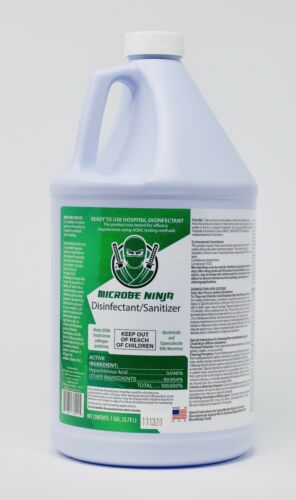-40%
NEW SPORICIDIN DISINFECTANT SOLUTION 1 GALLON CONTINUOUS ACTIVITY UPTO 6 MONTHS
$ 23.67
- Description
- Size Guide
Description
Sporicidin Disinfectant Solution 1 U.S. GallonSporicidin Brand Disinfectant Solution is a EPA registered intermediate level disinfectant with a broad spectrum kill which cleans, disinfects, deodorizes. Provides 100% kill of pathogenic vegetative organisms, including MRSA, VRE and Avian Influenza A Virus (H9N2 and H1N1). Continuous residual activity up to 6 months. Compatible with plastics, wood, glass and metals, alcohol-free Sporicidin Disinfectant is non-staining, non-abrasive and non-corrosive and OSHA compliant. With ratings in the lowest EPA toxicity category, Sporicidin has the most neutral pH of any phenolic based disinfectant. Available in ready-to-use 32 oz (0.65L) spray bottles and 1 gallon (3.8L) containers. Presaturated wipes are available.
This List N product meets the EPA’s criteria for use against SARS-CoV-2, the virus in the present pandemic. EPA Registration Number: 8383-3.
SECTION 2 : COMPOSITION/INFORMATION ON INGREDIENTS
Chemical Name
CAS#
Ingredient Percent
EC Num.
Water
7732-18-5
>95 by weight
231-791-2
Phenol
108-95-2
1.56 by weight
203-632-7
Sodium Phenate
139-02-6
0.06 by weight
205-347-3
SECTION 3 : HAZARDS IDENTIFICATION
Emergency Overview:
WARNING! Irritant.
Route of Exposure:
Eyes. Skin. Inhalation. Ingestion.
Potential Health Effects:
Eye:
May cause irritation.
Skin:
May cause irritation.
Inhalation:
Prolonged or excessive inhalation may cause respiratory tract irritation.
Ingestion:
Ingestion can cause gastrointestinal irritation, nausea, vomiting and diarrhea.
Target Organs:
Eyes. Skin. Respiratory system. Digestive system.
SECTION 4 : FIRST AID MEASURES
Eye Contact:
Immediately flush eyes with plenty of water for at least 15 to 20 minutes. Ensure adequate flushing of the eyes by separating the eyelids with fingers. Get immediate medical attention.
Skin Contact:
Immediately wash skin with plenty of soap and water for 15 to 20 minutes, while removing contaminated clothing and shoes. Get medical attention if irritation develops or persists.
Inhalation:
If inhaled, remove to fresh air. If not breathing, give artificial respiration or give oxygen by trained personnel. Seek immediate medical attention.
Ingestion:
If swallowed, do NOT induce vomiting. Call a physician or poison control center immediately. Never give anything by mouth to an unconscious person.
Other First Aid:
First Responders should provide for their own safety prior to rendering assistance.
SECTION 5 : FIRE FIGHTING MEASURES
Flash Point:
Not determined.
Auto Ignition Temperature:
Not determined.
Lower Flammable/Explosive Limit:
Not determined.
Upper Flammable/Explosive Limit:
Not determined.
Fire Fighting Instructions:
Evacuate area of unprotected personnel. Use cold water spray to cool fire exposed containers to minimize risk of rupture. Do not enter confined fire space without full protective gear. If possible, contain fire run-off water.
Extinguishing Media:
Use dry chemical or foam when fighting fires involving this material. Water mist may be used to cool closed containers.
Protective Equipment:
In the event of a fire, wear Self-Contained Breathing Apparatus (SCBA), approved or in accordance to NFPA, NIOSH, and/or European Standard EN 137 guidelines or equivalent and full protective gear.
Unusual Fire Hazards:
Material may spatter above 100 °C/212 °F.
NFPA Ratings:
NFPA Health:
1
NFPA Flammability:
1
NFPA Reactivity:
0
SECTION 6 : ACCIDENTAL RELEASE MEASURES
Personal Precautions:
Evacuate area and keep unnecessary and unprotected personnel from entering the spill area.
Environmental Precautions:
Avoid runoff into storm sewers, ditches, and waterways.
Methods for containment:
Contain spills with an inert absorbent material such as soil, sand or oil dry.
Methods for cleanup:
Absorb spill with inert material (e.g., dry sand or earth), then place in a chemical waste container. Provide ventilation. Clean up spills immediately observing precautions in the protective equipment section.
SECTION 7 : HANDLING and STORAGE
Handling:
Use with adequate ventilation. Avoid breathing vapor, aerosol or mist.
Storage:
Store in a cool, dry, well ventilated area away from sources of heat and incompatible materials. Keep container tightly closed when not in use.
Store away from direct heat or sunlight, sources of UV radiation, peroxides, or free radicals.
Do not store in temperatures above 49°C (120 °F) or below 9°C (48 °F). Keep away from direct sunlight.
Work Practices:
Handle in accordance with good industrial hygiene and safety practices.
Hygiene Practices:
Wash thoroughly after handling.
SECTION 8 : EXPOSURE CONTROLS, PERSONAL PROTECTION - EXPOSURE GUIDELINES
Engineering Controls:
Use appropriate engineering control such as process enclosures, local exhaust ventilation, or other engineering controls to control airborne levels below recommended exposure limits. Good general ventilation should be sufficient to control airborne levels. Where such systems are not effective wear suitable personal protective equipment, which performs satisfactorily and meets OSHA or other recognized standards. Consult with local procedures for selection, training, inspection and maintenance of the personal protective equipment.
Eye/Face Protection:
Wear appropriate protective glasses or splash goggles as described by 29 CFR 1910.133, OSHA eye and face protection regulation, or the European standard EN 166.
Skin Protection Description:
Wear appropriate protective gloves and other protective apparel to prevent skin contact. Consult manufacturer's data for permeability data.
Hand Protection Description:
Nitrile rubber or natural rubber gloves are recommended.
Respiratory Protection:
Use a NIOSH/MSHA or European Standard EN 149 approved respirator if exposure limits are exceeded or if irritation or other symptoms are experienced.
Comply with the OSHA respirator regulations found in 29 CFR 1910.134 or European Standard EN 149
Use a positive pressure air supplied respirator if there is any potential for an uncontrolled release, exposure levels are not known, or any other circumstances where air purifying respirators may not provide adequate protection.
Other Protective:
Facilities storing or utilizing this material should be equipped with an eyewash and a deluge shower safety station.











